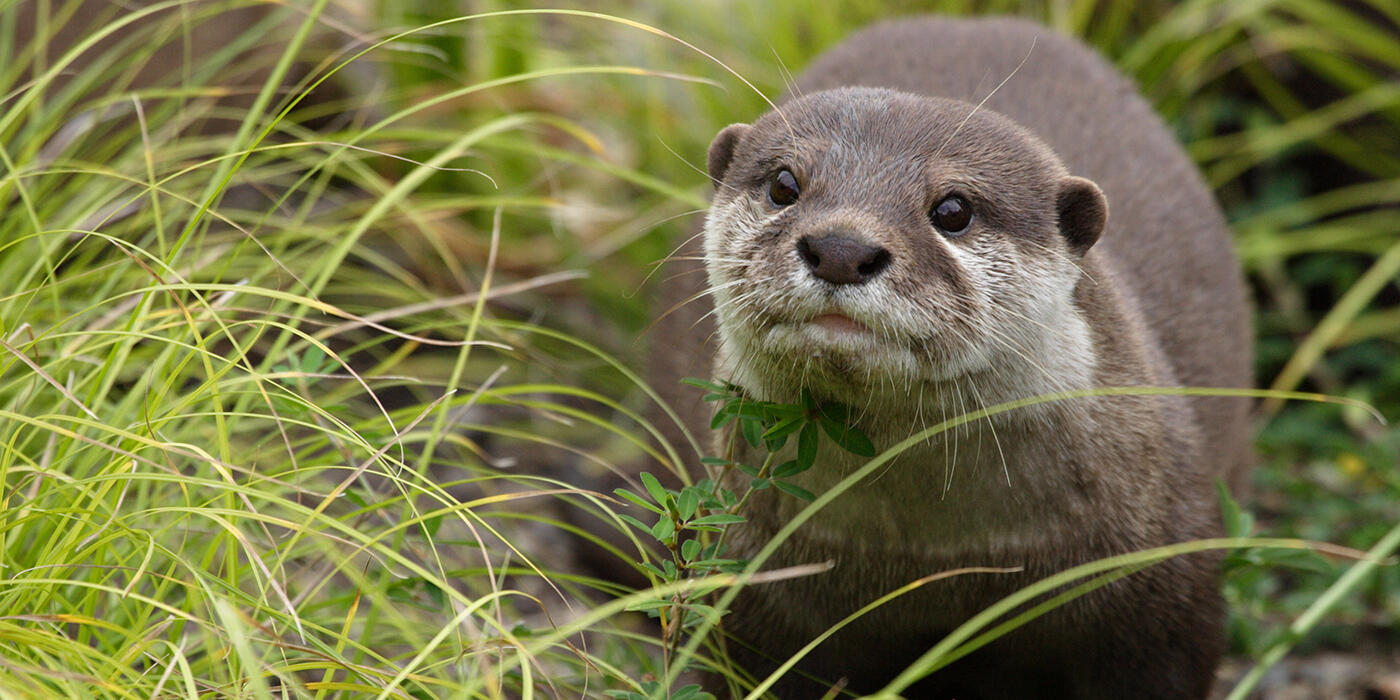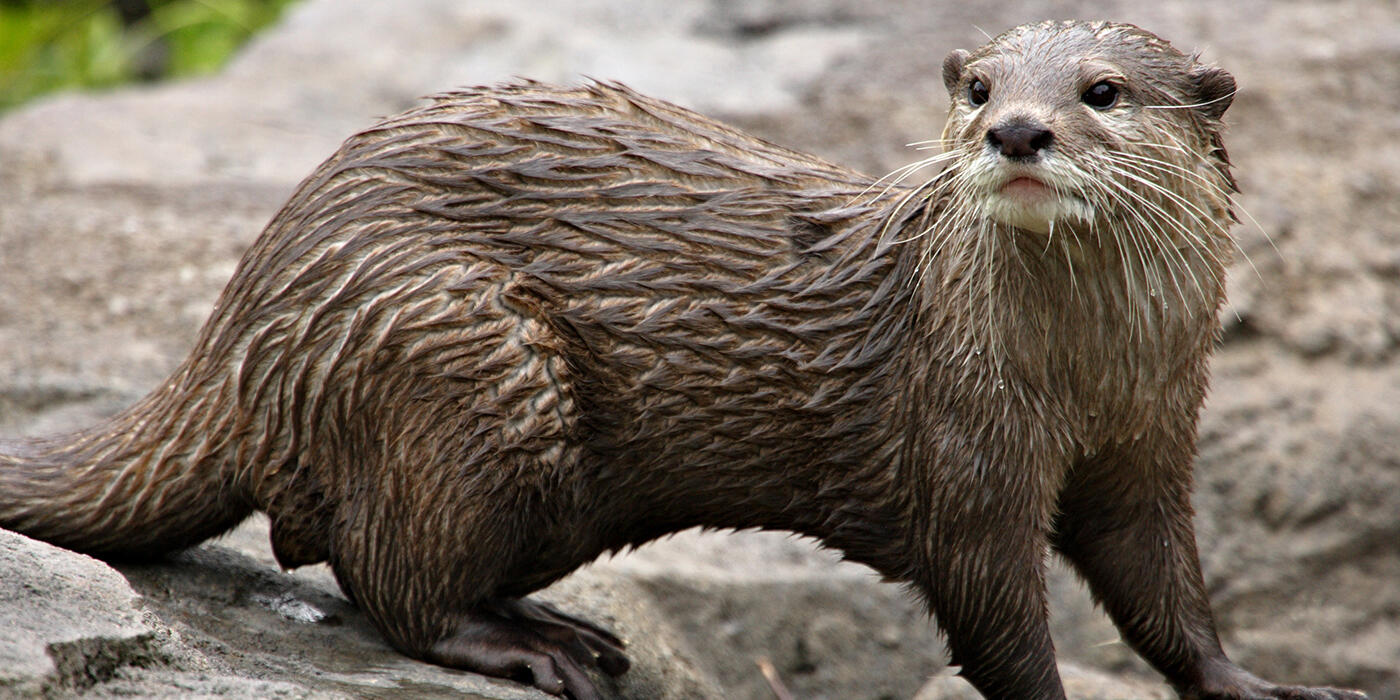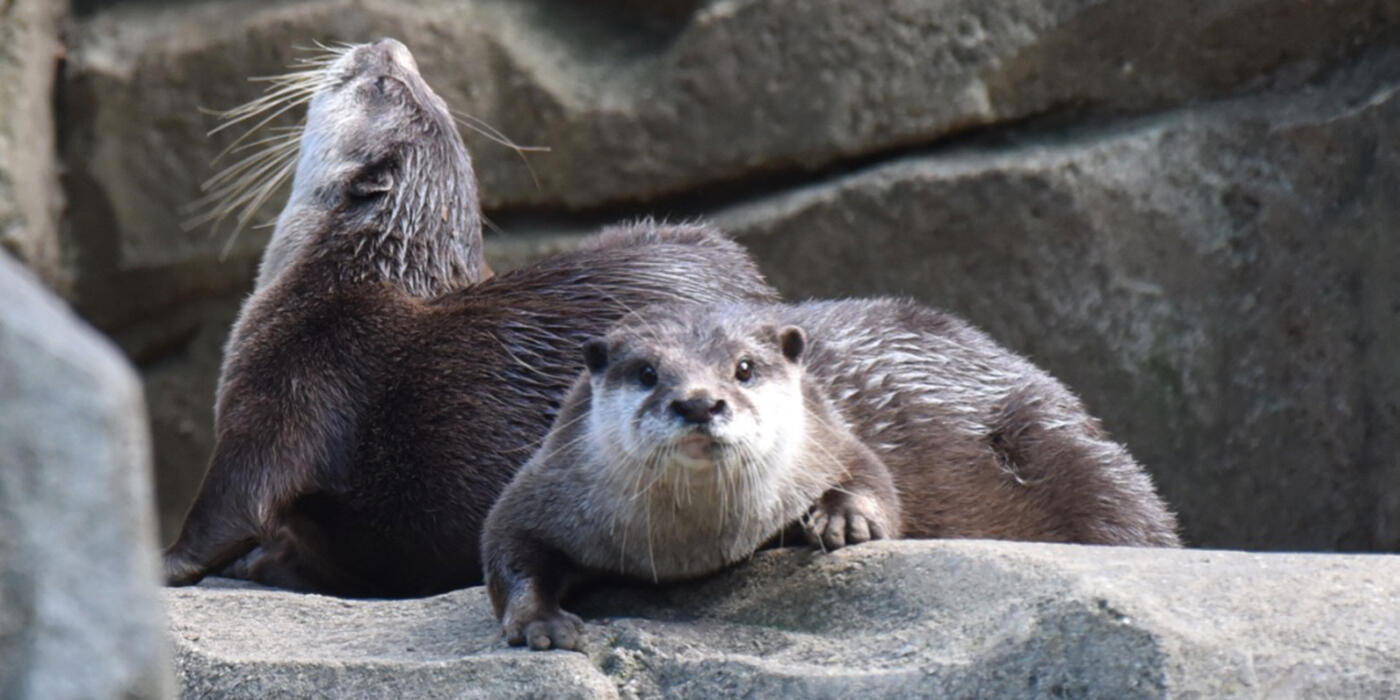Physical Description
These otters have dark brown fur above and lighter fur below, often with gray, white, or cream-colored markings on the face and throat. They have webbed feet, and true to their name, their claws do not extend beyond their digital pads.
Size
The smallest of the 13 otter species, weighing less than 10 pounds (4.5 kilograms) and measuring up to two feet (61 centimeters) long—with 10 to 14 inches (25 to 35 centimeters) of that being tail.
Native Habitat
Asian small-clawed otters are found in southern India, southern China, Southeast Asia, Indonesia and the Philippines. These otters live in small streams, rivers, marshes, rice paddies, seacoasts and in mangroves. They share their habitat with three other species of otter: Eurasian, smooth coated and hairy nosed.
Lifespan
Asian small-clawed otters live up to 12 years in human care, with some individuals living longer than 20 years. Lifespan in the wild is unknown.
Communication
Asian small-clawed otters are a very vocal species and have a vocabulary of at least twelve different vocalizations. Vocalizations are used for contact, summons, greeting, threat and alarm calls and can occur visually, chemically, or through tactile cues such as social grooming, hormonal changes and posturing.
These otters also use scent markings as an important form of communication. With paired scent glands at the base of the tail, otters emit an intensely musky smell that can delineate territory and communicates information concerning identity, sex, sexual receptivity and time elapsed between scenting visits. They tend to defecate or spray in communal latrine areas to pass on this information.
Food/Eating Habits
In the wild the otters eat primarily crustaceans and mollusks but will also eat fish, insects, amphibians and reptiles. Asian small-clawed otters use their forepaws rather than their mouth to locate and capture food items. Incomplete webbing between the toes gives them a great deal of manual dexterity. They have sensitive digital pads that help them feel under rocks or in murky water for food. They dig in sand and mud at the shoreline for various types of shellfish (clams and mussels) and crabs. To get at the meat, they either crush the shell by hand or let heat from the sun open the shells. Their teeth are broad and robust, well suited for crushing shells.
At the Smithsonian's National Zoo, Asian small-clawed otters are fed a prepared meat diet called Natural Balance, small fish such as smelt and capelin, canned feline diet and kibble. Like domestic cats, Asian small clawed otters have a propensity to develop kidney stones, so they are given cat food which includes ingredients that prohibit the growth of these stones. They are also given crabs, mussels, clams, mealworms, crickets, live crayfish and live goldfish as enrichment items. With a very rapid metabolism, otters have boundless energy, but a meal passes through their system in just a few hours. Because of this, they are fed multiple times a day.
Social Structure
This is a social species, living in family groups of up to 15 to 20 individuals. Although they live in groups, they hunt by themselves.
Reproduction and Development
Small-clawed otters start exhibiting breeding behavior around six months old, although they generally are not sexually mature until one and a half years. The most successful breeding occurs between 1.5 and 3 years old. Once they are mature, they can breed year-round. They dig nesting burrows called holts into the muddy banks where they live. The female's estrous cycle is 28 days, with a three-day period of estrus. After a gestation period of 68 to 72 days, females give birth to a litter of one to six pups. Typically, two litters of pups are born each year, 8 or 9 months apart. All members of the family group help feed and care for the young.
Conservation Efforts
Small-clawed otters are an excellent biological indicator species, located at the top of the food chain and with a wide geographical distribution. They are highly sensitive to habitat disturbance — ranging from destruction to pollution — and their numbers give scientists an indication of the general health of their environment.
In the last 60 years, the range of the small-clawed otter has shrunk considerably, moving from west to east. The main potential threat to Asian small-clawed otters is destruction of habitats due to changing land use patterns and increased development. In many parts of Asia, the habitats have been reduced due to reclamation of peat swamp forests and mangroves, aquaculture activities along the inter-tidal wetlands and loss of hill streams. In India the primary reason for loss of habitats are tea and coffee plantation along the hills, as well as loss of mangroves in the coastal areas due to aquaculture, increased human settlements and siltation of smaller hill streams due to deforestation. Increased influx of pesticides into the streams from the plantations reduces the quality of the habitats.
The next important threat to Asian small-clawed otter is reduction in prey biomass due to overexploitation. Pollution is probably the single most serious factor causing decline in the population of many fish species. Reduction in prey biomass affects otter populations, and organochloric and heavy metal contamination interferes with the normal physiology of otters, leading to the decline in population.
It is unknown how many Asian small-clawed otters exist in the wild, but there have been periods of rapid population decline. Camera traps set to study fishing cats frequently capture shots of otters.
In 1981, a Species Survival Plan program was established for the Asian small-clawed otter, to be used as a model for other, more endangered social otter species. It was generally believed that otters would be difficult to breed reliably in human care, so work on appropriate husbandry procedures was begun on the small-clawed otters. Although not yet endangered, this is a valuable species to begin research on before breeding of other endangered otters was needed. By 1985 the first studbook was published and three years later a full master plan was developed. Intensive work has been done to learn more about the female reproductive cycle and the unique diseases to which this animal is susceptible.
Help this Species
Reduce, reuse and recycle — in that order! Cut back on single-use goods, and find creative ways to reuse products at the end of their life cycle. Choose recycling over trash when possible.
Share the story of this animal with others. Simply raising awareness about this species can contribute to its overall protection.
Meet the Animals
The Zoo’s Asian small-clawed otter family includes two groups: a female Valerie with a male Chowder, as well as a female Rutabaga with a male Yuki.
Smithsonian's National Zoo and Conservation Biology Institute. (n.d.). Asian small-clawed otter. Retrieved January 6, 2026, from https://nationalzoo.si.edu/animals/asian-small-clawed-otter






